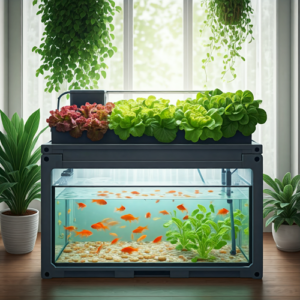
As an aquaponics enthusiast, I’ve often been asked, “How many fish per gallon can I grow in aquaponics?” It’s a crucial question that can make or break your system’s success. In this article, I’ll share my insights and experiences to help you determine the optimal fish stocking density for your aquaponics setup.
Understanding Aquaponics
What is Aquaponics?
Before we dive into the specifics of fish-to-gallon ratios, let’s quickly recap what aquaponics is all about. Aquaponics is a sustainable farming method that combines aquaculture (raising fish) with hydroponics (growing plants in water). In this symbiotic system, fish waste provides nutrients for the plants while the plants filter the water for the fish.
The Importance of Fish-to-Plant Ratio
Getting the right balance between fish and plants is crucial for a thriving aquaponics system. Too many fish can lead to excess waste and poor water quality, while too few fish may not provide enough nutrients for your plants. That’s why understanding the optimal fish-to-gallon ratio is so important.
Factors Affecting Fish Stocking Density
Several factors influence how many fish you can safely grow per gallon in your aquaponics system:
Fish Species
Different fish species have varying space requirements and produce different amounts of waste. For example, tilapia can tolerate higher stocking densities compared to trout.
System Size
Larger systems can generally support higher fish densities due to better water stability and more efficient filtration.
Filtration Capacity
The effectiveness of your biofilter plays a significant role in determining how many fish your system can support.
Water Quality
Maintaining optimal water parameters is crucial for fish health and plant growth. Overcrowding can quickly lead to poor water quality.
Calculating Fish-to-Gallon Ratio
General Rule of Thumb
As a starting point, I recommend following this general rule: stock 1 pound of fish for every 5-10 gallons of water. This ratio provides a good balance for most small to medium-sized aquaponics systems.
Specific Calculations
For more precise calculations, consider the following formula:
Fish biomass (lbs) = Total water volume (gallons) ÷ 7
This formula assumes a moderate stocking density suitable for most home aquaponics systems.

Optimal Fish Stocking Densities for Different Species
Let’s look at some popular fish species and their recommended stocking densities:
Tilapia
Tilapia are hardy fish that can tolerate higher stocking densities. I’ve successfully kept tilapia at 1 pound per 3-5 gallons of water.
Trout
Trout require cooler, well-oxygenated water and more space. Aim for 1 pound of trout per 8-10 gallons of water.
Catfish
Catfish are another hardy species suitable for aquaponics. Stock them at about 1 pound per 5-7 gallons of water.
Koi
While not typically raised for food, koi are popular in ornamental aquaponics systems. Stock koi at 1 pound per 10-20 gallons of water, as they require more space.
Balancing Fish and Plant Growth
Nutrient Requirements
The key to a successful aquaponics system is providing enough nutrients for your plants without overloading the system with fish waste. I’ve found that leafy greens generally require less nutrients than fruiting plants, so you can often support more fish when growing lettuce or herbs compared to tomatoes or peppers.
Adjusting Ratios
Don’t be afraid to experiment and adjust your fish-to-plant ratio as you go. Start with a conservative stocking density and gradually increase it while monitoring plant growth and water quality.
Monitoring and Maintaining Your Aquaponics System
Regular Water Testing
I can’t stress enough the importance of regular water testing. Monitor ammonia, nitrite, nitrate, pH, and dissolved oxygen levels at least weekly. This will help you catch any imbalances early and adjust your fish stocking density if needed.
Observing Fish Behavior
Pay attention to your fish’s behavior. If they seem lethargic or are gasping at the surface, it could be a sign of overcrowding or poor water quality.
Common Mistakes to Avoid
In my years of experience with aquaponics, I’ve seen (and made) some common mistakes:
- Overstocking too quickly
- Neglecting water quality testing
- Underestimating filtration needs
- Choosing incompatible fish and plant species
Avoid these pitfalls by starting small, monitoring closely, and scaling up gradually.
Scaling Up Your Aquaponics System
As you become more comfortable with managing your aquaponics system, you might want to increase your production. When scaling up, remember to:
- Increase fish stocking density gradually.
- Upgrade filtration as needed
- Consider adding aeration to support higher fish densities.
- Diversify your plant selection to balance nutrient uptake.
Conclusion
Determining how many fish per gallon you can grow in aquaponics is both an art and a science. While general guidelines are helpful, every system is unique. Start with conservative stocking densities, monitor your system closely, and adjust as needed. With patience and attention to detail, you’ll find the perfect balance for your aquaponics setup.
FAQs
- Can I mix different fish species in my aquaponics system?
Yes, you can mix compatible species, but be sure to research their specific needs and behaviors to ensure they coexist peacefully. - How often should I feed my fish in an aquaponics system?
Generally, feed your fish 2-3 times a day, offering only as much as they can consume in about 5 minutes. - What should I do if I notice signs of overcrowding in my system?
Reduce feeding, increase aeration, and consider removing some fish or expanding your system’s capacity. - Can I use ornamental fish like goldfish in a food-producing aquaponics system?
While possible, it’s generally better to use edible fish species to maximize the efficiency and productivity of your system. - How long does it take for an aquaponics system to cycle and be ready for full stocking?
A new aquaponics system typically takes 4-6 weeks to fully cycle and establish beneficial bacteria before it’s ready for full fish stocking.


